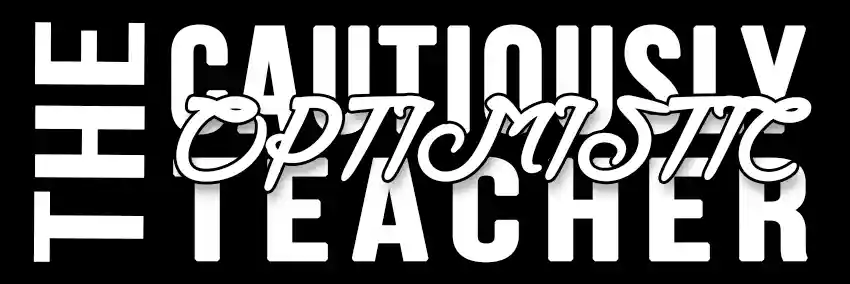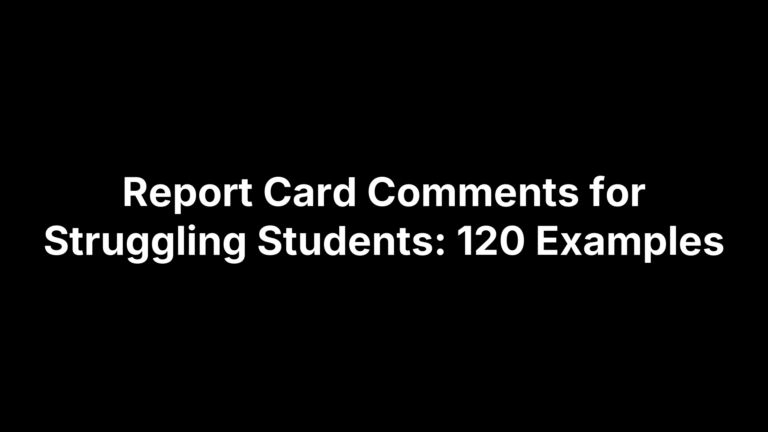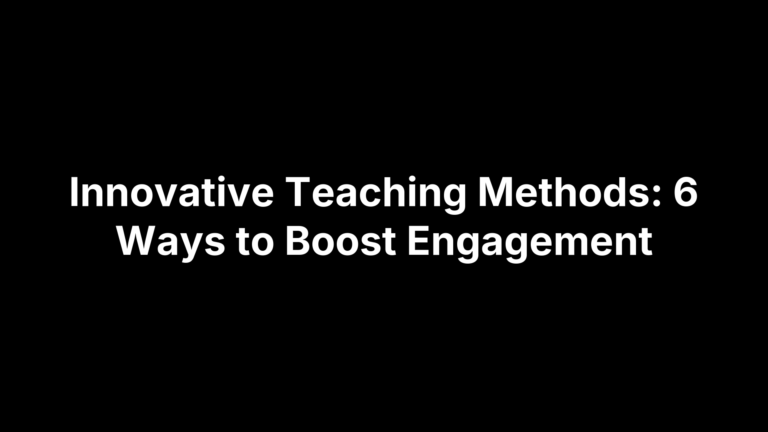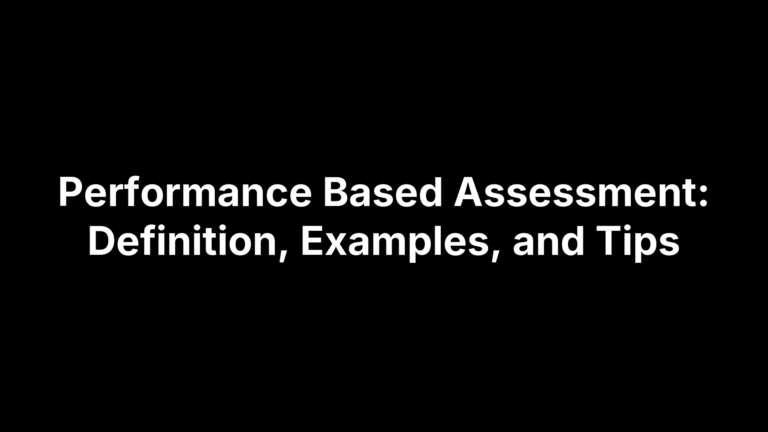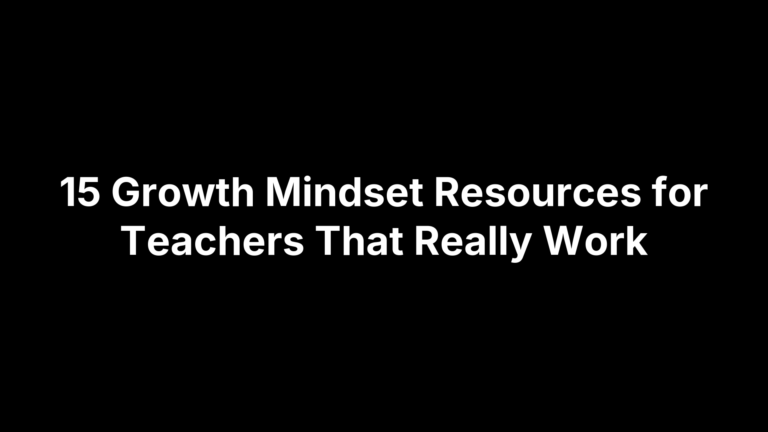How to Build a Positive Classroom Environment: A Teacher’s Guide
Look around any thriving classroom and you’ll notice the same invisible ingredient: students feel safe, valued, and eager to participate. When the climate is positive, academic scores climb, behavior incidents shrink, and social-emotional skills blossom—all without adding hours to your workload. The good news? A welcoming atmosphere isn’t a mysterious talent; it’s the product of intentional choices, backed by decades of classroom research, that any teacher can weave into the school day.
In the pages ahead, you’ll find 15 concrete strategies—each paired with why it works and step-by-step instructions to try tomorrow. From co-creating class routines to weaving growth mindset language into feedback, these ideas are field-tested and flexible across grade levels. Skim for fresh inspiration or commit to a full makeover; either way, the blueprint for a more positive classroom starts on the next line. Grab a notebook, pick two to pilot, and watch the energy in your room shift.
1. Establish Clear, Consistent Expectations and Routines
Clear expectations and predictable routines are the backbone of classroom stability. When everyone knows what comes next, you reclaim minutes for teaching and students relax into learning instead of scanning for danger.
Why Consistency Sets the Tone
Brain-based studies and PBIS data show that well-rehearsed routines can cut transition misbehavior by 50 % and boost on-task time. Predictability signals psychological safety: if lining up, logging in, or asking a question always follow the same rhythm, students’ cognitive load shifts from deciphering rules to processing content—essential for building a positive classroom environment.
How to Craft & Teach Routines
Choose one procedure—entry/exit, Chromebook signal, bathroom pass—and script the exact steps. Model it twice (perfect and “almost” versions), then practice until the class nails it in under 30 seconds. Add a visual cue near the door, narrate successes, and reteach briefly after breaks to keep muscle memory fresh.
Troubleshooting & Refinement Tips
When a routine unravels mid-year, treat it like new learning: revisit the anchor chart, time the transition, gather student feedback, and set a one-day improvement goal. Iterate until the data—and the vibe—bounce back.
2. Build Positive Relationships with Students
Relationships grease every other strategy on this list. When students feel known, oxytocin rises, stress levels fall, and engagement soars. A few intentional rituals can transform rapport in under two weeks.
Get to Know Students as Individuals
Start with data: quick interest surveys, “this or that” Kahoots, and hallway small talk. Greet each learner by name at the door, and aim for the “three hugs, handshakes, or high-fives” rule every day.
Demonstrate Authentic Care and Respect
Listen with eyes as well as ears—paraphrase feelings and ask follow-ups. Use culturally responsive language; pronounce names correctly. Praise publicly, correct privately, and ditch sarcasm or public shaming that erode trust instantly.
Relationship-Building Activities
Embed community moments: Monday “rose, thorn, bud” circles, monthly teacher-student lunch bunches, and mid-unit climate surveys. Rotate who shares first so quieter voices surface, and end sessions with appreciative applause to reinforce connection.
3. Create a Respectful and Inclusive Classroom Culture
A respectful, inclusive culture turns rules into lived habits. When every learner feels seen and safe, participation rises and conflict drops, laying the groundwork for building a positive classroom environment that endures.
Setting Norms Collaboratively
Kick off day one with a “norm-storm.” Small groups list behaviors that help them learn; you synthesize and rewrite as collective “we” statements—“We listen to understand.” Sign the chart and review it at weekly check-ins.
Addressing Bias & Microaggressions Proactively
Normalize calling out harm quickly. Teach the two-word ‘Oops/Ouch’ routine: the speaker says “oops” and rephrases; the hurt peer says “ouch” and explains. Role-play simple ally phrases during advisory.
Celebrating Diversity
Keep representation visible. Rotate monthly culture spotlights with music or guest stories, label common items bilingually, and host a “Culture Corner” where families share artifacts that mirror students’ identities.
4. Design a Comfortable, Student-Centered Physical Space
The room itself sends constant messages. A few intentional tweaks to light, layout, and accessibility can lower stress hormones, bump attention spans, and quietly support every other strategy on this list.
Environmental Factors That Influence Learning
- Soft, indirect lighting reduces eye strain and keeps circadian rhythms steady.
- A thermo-neutral range (68–72 °F) prevents “too hot to think” meltdowns.
- Flexible seating clusters dampen noise and invite collaboration; carpets or tennis balls on chair legs cut disruptive echoes. Brain-imaging studies show calmer limbic activity when students can easily see, hear, and move.
Low-Cost Classroom Makeovers
- Shuffle desks into pods or a horseshoe.
- Add a plant, student art, or a lamp for homey vibes.
- Repurpose crates for DIY storage and carve out a quiet nook with a rug and headphones.
Universal Design for Learning (UDL) Touchpoints
- Offer multiple seating heights, including floor cushions and standing desks.
- Keep sightlines clear of tall bookcases.
- Color-code materials and label in large print/Braille.
- Ensure pathways are wheelchair-friendly and provide fidgets or noise-reducing earbuds for sensory regulation.
5. Incorporate Student Voice and Choice
Voice and choice give students a stake in the game, transforming compliance into commitment. Layering autonomy into lessons is a fast track to building a positive classroom environment.
Why Autonomy Fuels Engagement
Self-Determination Theory reminds us that when learners feel competent, connected, and free to choose, their intrinsic drive skyrockets. Autonomy also cuts power struggles, leaving more minutes for deep thinking.
Practical Ways to Offer Choice
Offer structured options: assignment menu boards, student-selected reading lists, or flexible pacing checkpoints. Quick polls in Google Forms or Mentimeter let the class steer examples, topics, and even seating charts.
Managing Choice Without Chaos
Post choice boards with clear must-do and may-do tasks, use brief learning contracts to lock deadlines, and open the day with “soft starts” so students settle into self-selected work right away.
6. Use Positive Reinforcement and Recognition
Positive reinforcement is gasoline for motivation; when students notice their effort getting noticed, the brain releases dopamine and quietly whispers, “do that again.” Replace vague praise with targeted recognition and watch engagement climb.
Science Behind Positive Feedback
Neuroscience shows dopamine neurons fire when feedback is immediate, specific, and attainable. A 4:1 ratio of positive to corrective comments, validated by PBIS meta-analyses, correlates with higher GPA and 30 % fewer office referrals.
Systems That Work
Implement layered systems: a class shout-out wall for daily peer kudos, digital badges in Google Classroom for mastering skills, and weekly phone calls home spotlighting quiet achievers. Post clear success criteria so students can link recognition to behaviors they control.
Avoiding Common Pitfalls
Avoid reward inflation: phase out tokens as habits stick and shift praise toward perseverance and strategy. Keep competition low by honoring collective milestones alongside individual wins.
7. Teach and Model Social-Emotional Skills
Social-emotional learning (SEL) isn’t a once-a-week add-on; it’s the heartbeat of building a positive classroom environment. When students label feelings and navigate conflict, academic risk-taking feels safer.
Embedding SEL Into Daily Routines
Start small: a 60-second feelings check during attendance, a mindfulness bell after recess, or an exit ticket asking “What emotion best describes your learning?” Tie each to CASEL’s five competencies so practice becomes purposeful rather than decorative.
Teacher Modeling Strategies
Students imitate what they see, not what we say. Narrate your own coping: “I’m frustrated, so I’ll breathe twice before I respond.” Use the three-step “feel–think–choose” aloud during tough moments.
Assessing SEL Growth
Data matters here, too. Have learners self-rate on emoji scales each Friday, log conflict-resolution reflections, and invite peers to give “warm feedback.” Compare weekly tallies to office referrals to gauge real-world transfer.
8. Make Learning Relevant and Culturally Responsive
Nothing disengages students faster than lessons that feel detached from their realities. By rooting activities in their cultures, interests, and communities, you honor identity while quietly building a positive classroom environment where curiosity can thrive.
Connecting Curriculum to Students’ Lives
Relate content to what’s happening outside your door:
- Graph TikTok trend data in algebra.
- Compare local news stories to historical primary sources.
- Invite community experts for career-path Q&As.
When students see themselves in the work, rigor no longer feels like busywork.
Culturally Responsive Pedagogy Basics
Lean on students’ “funds of knowledge.”
- Rotate “window, mirror, sliding-glass-door” texts.
- Use cooperative norms that respect varied communication styles.
- Counter single stories with multiple perspectives to guard against tokenism.
Differentiation Through Relevance
Offer choice tied to interest: podcast, comic, or infographic. Real-world math problems—budgeting a class trip, redesigning playground space—let every learner practice standards while showing off personal passions.
9. Foster Collaboration and Cooperative Learning
Effective teamwork builds communication and problem-solving muscles while reinforcing academic concepts—double-dipping that strengthens a positive classroom environment. Shared responsibility also boosts peer relationships and reduces stigma around mistakes. Structure, explicit skill instruction, and quick monitoring keep groups productive instead of letting one student carry the load.
Structuring Effective Group Work
- Assign rotating roles: facilitator, recorder, reporter
- Give a task card with purpose and timeline
- Use Jigsaw or Think-Pair-Share for built-in turn-taking
- Close with a 1-minute group self-check against criteria
Teaching Collaboration Skills Explicitly
Model listening stems (“I hear…”) and co-create a simple teamwork rubric; rehearse skills during a quick, low-stakes challenge before graded projects.
Monitoring and Supporting Groups
Roam with color status cards—green, yellow, red—to triage needs, ask probing questions, and collect notes for tomorrow’s regrouping.
10. Integrate Growth Mindset Language and Practices
Mindset is the inner story of ability. Treat struggle as data, not drama, and the drive to learn powers a truly positive classroom—an essential ingredient for building a positive classroom environment.
Shifting Student Self-Talk
Post an anchor chart contrasting fixed with growth phrases—“I give up” shifts to “I need a new plan.” Add the word “yet” whenever students say “I can’t.”
Classroom Practices That Reinforce Growth Mindset
Highlight errors with “favorite mistake” mini-talks, keep color-coded mastery folders for revisions, and share quick bios of innovators who failed forward, from Rowling to Dyson.
Communicating Feedback for Growth
Use single-point rubrics that note strengths and next steps. Hold the grade until reflection is done so students focus on process rather than point chasing.
11. Provide Clear Goals and Success Criteria
Crystal-clear objectives turn guesswork into focus, a non-negotiable for building a positive classroom environment. When students understand what success looks like, anxiety drops and effort zeroes in on learning.
Setting Learning Targets
Draft daily targets in plain language—“I can analyze theme using evidence.” Post them where eyes naturally land and reference them during mini-lessons so content, activity, and assessment stay aligned.
Co-Constructing Success Criteria
Next, unpack an exemplar together, asking students to name the moves that make it shine. Translate their observations into a two-column checklist of do’s and look-fors.
Ongoing Self-Assessment
Invite learners to color-code progress with traffic-light cards, update a digital tracker, or jot nightly reflection sentences; the instant feedback guides reteaching and celebrates incremental wins.
12. Use Proactive Classroom Management Techniques
Great management is like stage lighting—you only notice it when it’s missing. Planning systems up front prevents most hiccups and keeps the focus on learning, a cornerstone of building a positive classroom environment.
The 5 P’s Framework (Procedures, Practice, Positivity, Patience, Persistence)
- Procedures – script every routine so expectations are unmistakable
- Practice – rehearse until habits stick, then spot-check after breaks
- Positivity – spotlight what’s going right to reinforce desired behaviors
- Patience – respond in a calm tone; escalations shrink when adults model composure
- Persistence – reteach and refine instead of blaming students
Teachers who front-load the 5 P’s spend far fewer minutes reacting later.
Low-Key Responses to Misbehavior
Use invisible nudges before verbal corrections: stand near chatter, tap the desk, offer a choice, or direct a student to a two-minute “take a break” space. A 30-second private check-in preserves dignity and keeps the class momentum.
Data-Driven Adjustments
Track behavior frequencies or ABC charts weekly. Look for patterns—time of day, task type, seating. Pilot one tweak (lighting, grouping, brain break), review the numbers, and hold a brief restorative chat when data signal deeper needs.
13. Leverage Technology and Digital Tools to Support Engagement
A Chromebook, an iPad, or even a phone can either super-charge curiosity or sink it under notifications. The difference lies in intentionality. Thoughtfully chosen tech amplifies voice, speeds feedback, and personalizes paths—key levers for building a positive classroom environment without adding extra prep.
Selecting Tools That Enhance, Not Distract
Ask three quick questions before hitting “install”:
- Will this tool deepen thinking about today’s target?
- Can every student access its features, including text-to-speech and captions?
- Is the learning curve under five minutes?
Tools that pass—like Pear Deck for live checks or ClassroomScreen as a noise meter—keep focus on content, not clicks.
Digital Citizenship and Online Norms
Model “pause before post,” co-write a class tech agreement, and teach students to lock screens when peers share. Embed mini-lessons on privacy, sourcing images, and empathetic commenting so digital spaces mirror in-person respect.
Blending Tech With Traditional Methods
Balance screen time with kinesthetic stations: rotate from a Jamboard brainstorming hub to a hands-on lab and a notebook reflection center. Short, virtual exit tickets capture understanding while students pack up, giving you actionable data before the bell.
14. Reflect and Adapt Through Continuous Feedback Loops
Even the best routine drifts over time. Continuous feedback loops catch small issues early and keep the climate thriving. Picture them as a classroom fitness tracker—collect data, reflect, adjust.
Gathering Student Feedback Regularly
Use quick checks: Friday temperature polls, one-minute Google Forms, or a suggestion box. Ask, “What helped you learn?” then map trends to surface hidden friction.
Teacher Self-Reflection Practices
Wrap the day with three prompts—What worked? Why? Next step?—or record a five-minute clip for weekend review. Occasional peer walk-throughs reveal blind spots you can’t see alone.
Iterating on Classroom Strategies
Run tiny Plan-Do-Study-Act cycles: adjust one element—seating, brain-break timing—collect data for a week, then adopt, adapt, or toss it. Incremental pilots sharpen a positive classroom environment without burnout.
15. Encourage Family and Community Partnerships
Families and community partners are a force multiplier for a positive classroom. When adults beyond school echo your expectations, students hear a unified chorus that boosts motivation and belonging.
Building Trusting Relationships With Families
Lead with praise. Send a voice memo celebrating each child, provide translated messages, and host informal “coffee with the teacher” chats. Frequent contact builds goodwill before academic or behavior concerns arise.
Involving Families in Learning
Design homework that invites family input—heritage recipe math or interview a grandparent. Student-led conferences and Seesaw uploads let relatives witness progress and reinforce classroom goals at the kitchen table.
Leveraging Community Resources
Map neighborhood assets—museums, small businesses, service clubs. Invite a local engineer for STEM week, lead a park clean-up project, or land a DonorsChoose mini-grant to refresh supplies.
Bringing It All Together
Look back over the list and you’ll notice how each strategy strengthens the next. Clear routines free up cognitive space for relationship-building. Relationships lay the groundwork for respectful culture, which in turn makes collaboration, risk-taking, and growth mindset language stick. Layer in SEL, relevance, tech, and ongoing feedback, and the result is a safe, motivating, academically rich classroom climate—exactly the essence of building a positive classroom environment.
Big shifts happen through small, focused moves. Choose two strategies that feel doable this week—maybe reteaching a shaky routine and adding a one-minute feelings check. Track the impact for five days, adjust, then stack on a third practice. Momentum will build faster than you expect, because the pieces are designed to interlock.
Ready for more support? Explore free templates, AI-powered planning tools, and deeper dives into each approach at The Cautiously Optimistic Teacher. Your future classroom community will thank you.
